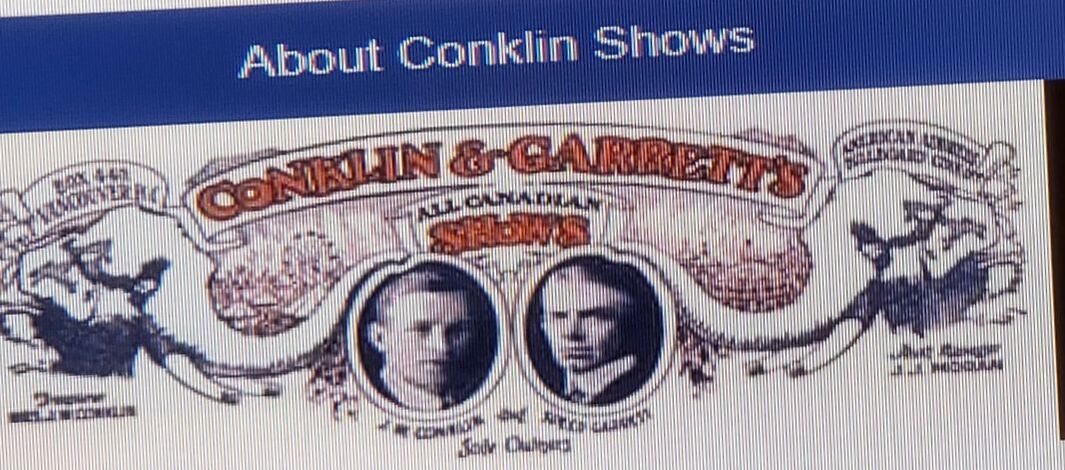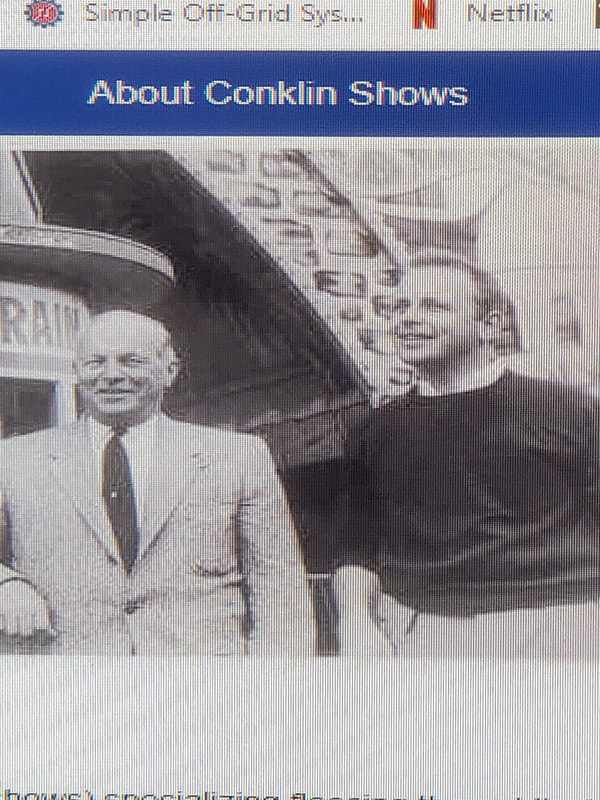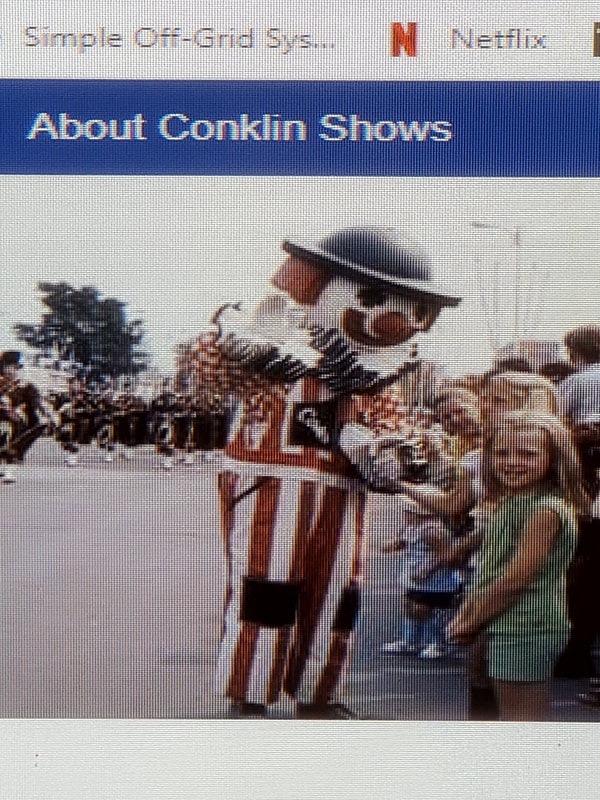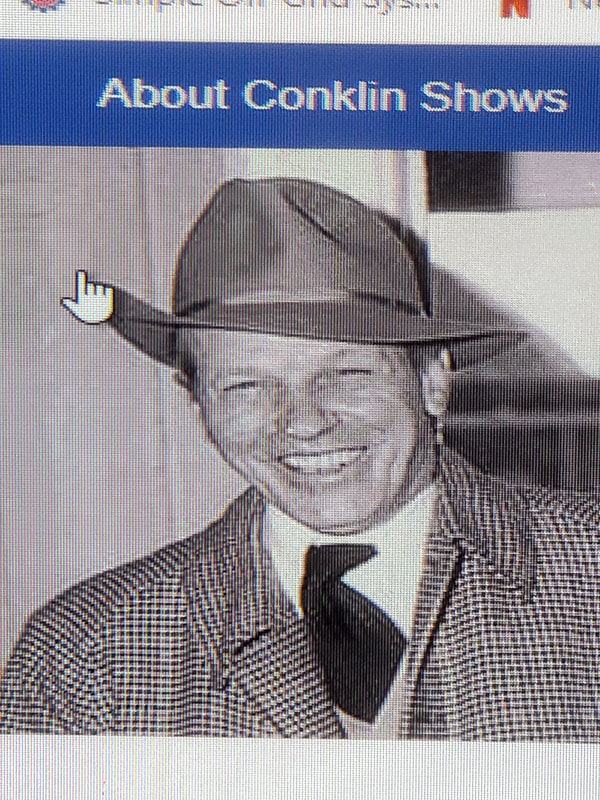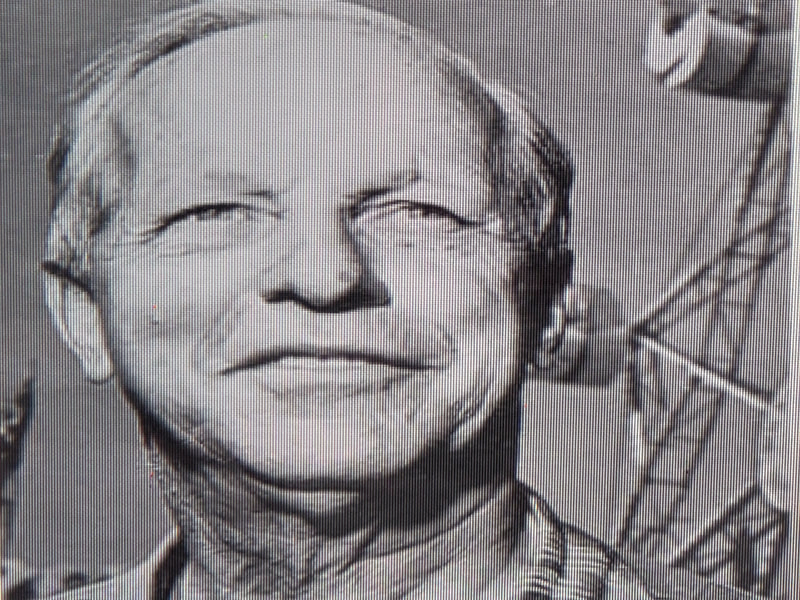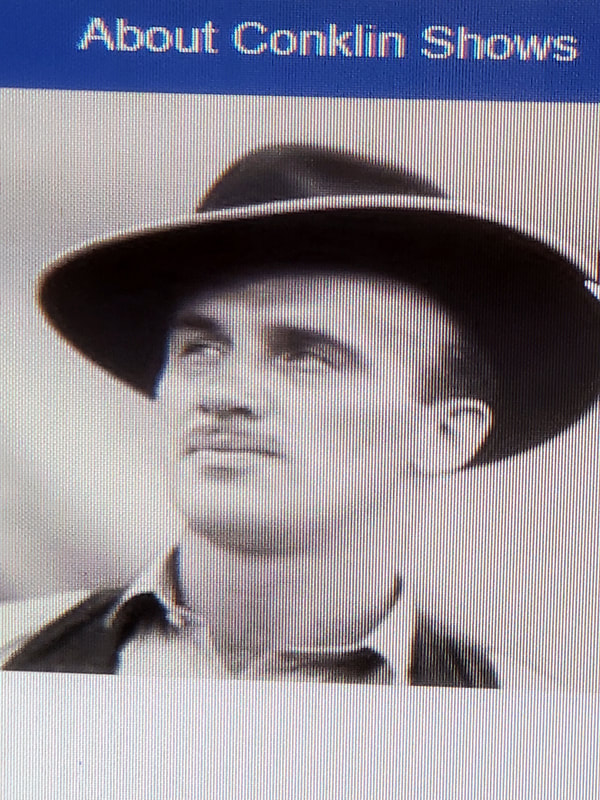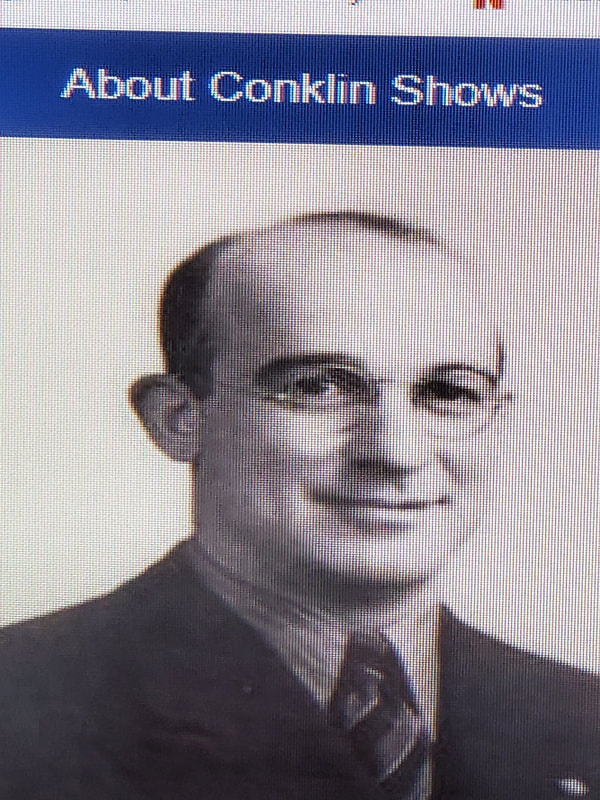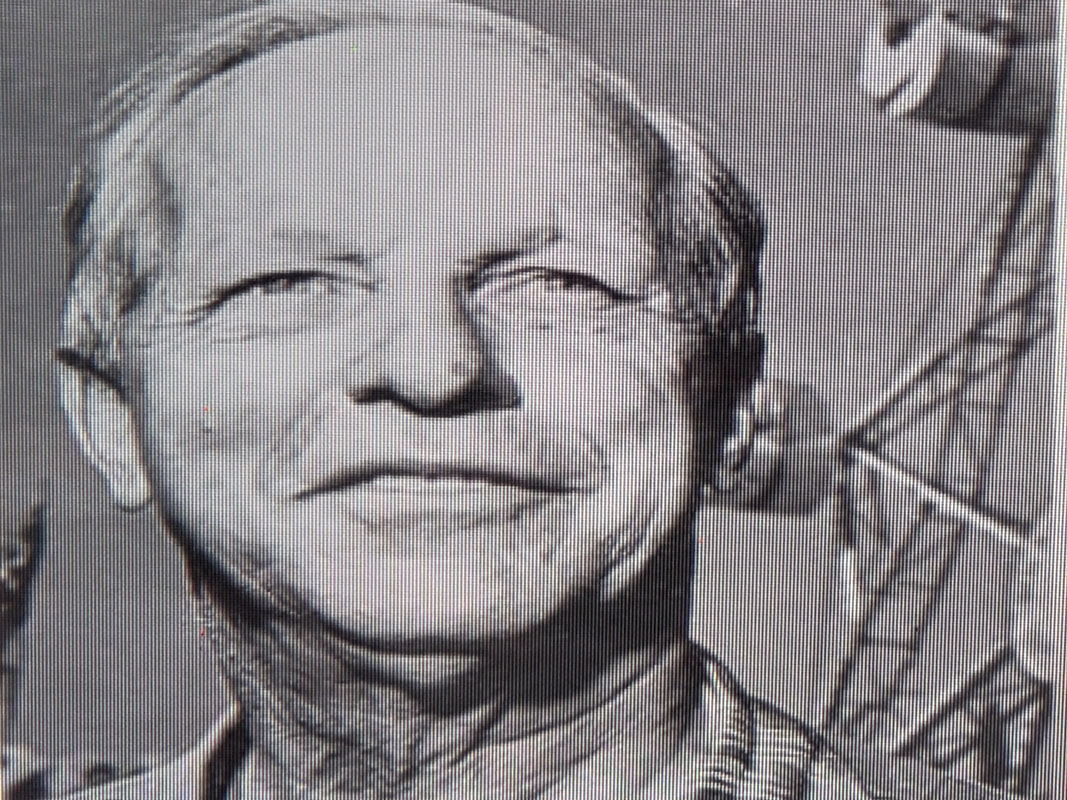About Conklin Shows
by Rob Connelly
In the 1920-30’s, most if not all carnivals were (graft shows) specializing fleecing the public. Most of the attraction including the shows, rides and games included a fraud of some kind. Conklin & Garrett, All Canadian Shows, Truthfully Advertised and Honourably Presented was no exception (both owners, Speed Garrett & J W (Patty) Conklin, were Americans).
The shows, freak, girly and others seldom presented what was painted on their banner lines, most games were fixed (controlled or flat stores), the food was often doctored and the ticket sellers on each ride or attraction were mostly short change artists. Patty Conklin team was one of the best, so much so it was nicknamed the “40 thieves”.
The early carnivals were so bad that Canada’s parliament passed a special Criminal Code section Z267 that pertained to carnival games. All carnivals carried a specialist (fixer or parch) to patch up the complaints (beefs) that resulted from the scams carried out joints (games) and the operators (agents). On The Conklin & Garrett Shows, the job was handled by Patty’s brother, Frank Renker Conklin.
Since the 1940s the carnival industry has changed dramatically there are no more shows, no more funny games and no more fraud of any kind but carnies in general are still trying to live down their past reputations.
The Founder
J. W. Patty ConklinThe U.S. fair dates Conklin Shows won in 1978 would have been something of a homecoming for James Wesley "Patty" Conklin, the show’s founder, born Joe Renker in Brooklyn in 1892. He left home around 1900, lived with foster parents for a while and then went out on his own. An immigrant kid on the streets of New York City, he sold peanuts, newspapers and herring, and worked as a sideshow talker on Coney Island. By the early 1910s, Patty was operating gambling games on midways in the wild-west oil boomtowns of Texas and Oklahoma. He not only survived, he made money.
Patty next joined up with the original J.W. Conklin, owner of Clark and Conklin Shows, which he began in 1916. The show played the mid-western states, folding after four seasons. Patty became one of the family, taking his adopted father’s name and staying with the Conklins when they went to work for other shows. J.W. Conklin, Sr., died on the road in the fall of 1920.
Patty and Mrs. Conklin remained in the United States for most of another year, then in the middle of the 1921 season, at Patty’s urging, he, his 18-year old brother Frank and his adopted mother decided to try Canada. They planned to book with Wortham Shows at the Winnipeg Exhibition, but the plan fell through. With their boxcar full of kewpie dolls, they were about to head back across the border when they spotted a rag-bag show playing St. Boniface, outside Winnipeg. They hooked up with the International Amusement Company and stuck with the show through its remaining Canadian dates that season. Their future lay in Canada.
Speed After a few seasons working tiny fairs, rodeos and vacant lots with various carnival companies in Canada’s growing west, Patty met Speed Garrett, part-owner of a small show based in Seattle. Conklin & Garrett Shows was born when Patty bought half of this operation in 1924. From two railroad cars, the company grew within a few years to fifteen. The relationship Patty developed with the Elks club helped the show grow, starting with a still date in Vancouver that became an annual affair to open the season. The show booked more and more spots under Elk auspices.
1928 Letterhead, Conklin & GarrettConklin & Garrett played small farming, mining and lumber communities throughout the prairie provinces and British Columbia. They worked the C circuit of fairs for several years, and eventually acquired the B circuit of larger fairs. The show grew to as many as 200 carnies, more than a dozen shows, five to six rides, and scores of games concessions or "joints," Patty’s specialty. In 1932 they ventured as far east as the Maritimes, losing money and skirting bankruptcy. Money was tight during the depression, but labour was cheap and the show survived. It remained a "gilly" outfit, traveling in railroad boxcars then hiring local draymen to cart the equipment to and from the lot. They somehow managed to play as many as four spots a week.
Speed contracted tuberculosis in 1927, spending less and less time on the road until becoming an invalid two years later. Patty bought Speed’s half of the show in 1930, selling it to brother Frank, even though Frank was hospitalized in a Los Angeles TB sanatorium, where he remained until 1932. In the meantime, Patty handled the carnival, attended the fair meetings and negotiated new fair contracts, almost single-handedly. Since 1924 the show had wintered in Vancouver. In 1932, Patty moved the show east to Hamilton, Ontario. Five years later he moved on to nearby Brantford, the location of the Conklin head office ever since. The show’s centre of gravity became Ontario, the home of the world's largest fair, the Canadian National Exhibition.
Showman
Patty was a showman’s showman, effortlessly occupying the centre of attention, whatever the crowd. He was elected president of the Pacific Coast Showmen’s Association in 1929, a position he thought would help the business. The following year he met and married an aspiring actress from Nanaimo. Edythe and Patty had one child, James, in 1933. Patty was elected president of the Showman’s League of America for both 1935 and 1936. Not since Buffalo Bill Cody, the League's founder in 1913, had any president been re-elected for a second term.
In 1935, Patty hosted the Showmen’s convention in Toronto. With his eye on the Canadian National Exhibition, he asked the new general manager of the Ex, Elwood Hughes, to act as toastmaster. Major American shows had been providing the midway at the CNE since it had become the biggest annual outdoor exhibition in the world, many years before. Against this competition, Conklin Shows bid and won the midway contract for 1937, partly because of Patty’s expertise and partly because of his rapport with Hughes. After the contract was signed, Elwood and Patty toured Europe to find the best and newest attractions. A polio epidemic hit Toronto that summer and attendance at the Ex fell sharply. Financially, it was a severe setback to both the show and the CNE.
By 1940, Conklin was making a profit on the Ex and in later years would shatter records for midway ride and show grosses for any exhibition, anywhere. In 1940, however, the exhibition grounds were taken over to billet and train troops for Canada’s war effort. The CNE would not resume operations until 1947. In the interim, Patty promoted a huge charity show, the Fair for Britain, at Christie Pits Park in Toronto, and was granted the right to play the coveted prairie A circuit of big fairs, including the Calgary Stampede. The war years were good for Patty. He retired and sold everything in 1946.
Renewal
Elwood Hughes lured Patty out of retirement and back to the CNE for 1947 with an unprecedented ten-year contract. Contract in hand, Patty invested in permanent attractions for the Ex. On a borrowed half million dollars, he built a permanent line up of games, fun houses, rides and shows. In 1953 he had the mighty Flyer built, a classic wooden roller coaster that remained a CNE landmark for 40 years. Midways used to be dominated by shows--freak, girl, athletic, illusion, animal and anything else that imaginative producers could contrive. As patrons have demanded more excitement, rides have taken over. Patty began exploring the festivals of Europe to find spectacular rides. In 1955 he set a new trend in the industry by purchasing right off the Octoberfest grounds North America's first major European spectacular, the Wild Mouse.
Back in the business, Patty concentrated on the Ex and, with brother Frank, on developing the eastern road show. He would never again play the fairs in the west. Under Frank's management and with the help of Jimmy Sullivan’s World’s Finest Shows, Conklin Shows began working a string of solid Ontario fairs and acquired all of the major fairs in Quebec. The show eventually got almost every big fair in the east, with the exception of Ottawa’s Central Canada Exhibition.
At the age of 70, Patty partnered with Harry Batt to produce the "Gayway" for the Seattle World’s Fair. World’s fair midways were notoriously unprofitable. Brother Frank and son Jim tried to talk him out of taking on this huge task at this juncture in his career, but Patty’s persistence won out. With imagination and energy belying his age, he helped make the Seattle midway a winner that has yet to be surpassed at a world’s fair.
Patty sent his son to a private school and then to McGill University in Montreal. Few expected Jim to fit into the rough world that was his father’s home. Jim began working games at Crystal Beach, accompanying his father on scouting trips, learning the fine points of running a road show office, attending the fair conventions and operating a line up of joints at the CNE. In 1963 Jim’s uncle Frank died from the multiple sclerosis that had crippled him for several years. Jim, 30 years old, stepped in to take over Frank's eastern road show operations.
Expansion
Patty survived the 1960s and Jim continued his training. Along with Jim, came Alfie Phillips, who had also apprenticed at the Crystal Beach amusement park. Alfie was another second-generation showman. Alfie Phillips, Sr., after his career as a world-class diver, including both the 1928 and 1932 Olympics, had produced water shows for Patty. Still working the Ex, one of the most respected men in the business, Patty died at 78 in 1970. Jim, Alfie and a roster of loyal and capable senior staff trained by Patty were ready to carry on.
Jim Conklin expanded on Patty’s legacy, but had his own ambitions for the show. He diversified its holdings with an amusement centre at the CN Tower in Toronto, partnership in a theme park in Niagara Falls and an amusement park on the Pacific National Exhibition grounds in Vancouver. Then fortune--and the Canadian government--threw Conklin Shows a plum it could not refuse.
Royal American Shows, at its peak the largest carnival company in North America, since 1946 had played the A circuit of western Canadian fairs, a circuit comprised of the Calgary Stampede and other big fairs in Brandon, Edmonton, Saskatoon, Regina and Winnipeg. Because they could all be booked as one through the Western Canada Fairs Association, this route was a real prize. During their 1975 Canadian season, Royal American was investigated by the RCMP and later by other Canadian authorities for tax evasion. Royal American was barred from working Canada. Conklin Shows acquired the A circuit for the season of 1976. Royal American would steadily decline until it folded in 1997.
With a lock on almost every major fair and exhibition in Canada, Conklin Shows set its sights south. In 1978 they bought Deggeler's Magic Midway, another major American show, this one based in Florida, with its U.S. route. To expand in Canada, Conklin & Garrett Ltd. purchased the Bernard and Barry Shows, an Ontario company. Conklin Shows even tried its hand in the Caribbean, playing Puerto Rico in 1979 with great success, but in Santo Domingo the following year they lost money badly. Back in Canada, interest rates were climbing and the country was entering a recession. The expansion came to an abrupt halt.
Third Generation
In 1980, Conklin & Garrett Ltd., under the management of Alfie and Jim, operated permanent amusement parks in Niagara Falls and Vancouver, three Ontario travelling shows, a large carnival in the U.S. and the big Canadian show. The operations included scores of rides and a myriad of game and food concessions, and employed hundreds of permanent and thousands of temporary carnies. In the fall of that year, the bank called in its seven million dollar loan. Rumours were rife that Conklin Shows was about to fold. To meet the show’s financial obligations, Jim restructured and downsized all operations. He sold excess equipment, sold or cut back on the show’s permanent locations and closed most of the U.S. route, keeping only those fairs that could be played prior to and following the core Canadian shows.
Another Conklin generation became active on the midway in the 1970s. Frank, born in 1959, started out moving the show's newest and largest rides. He gradually advanced in managerial responsibilities, until he took over Conklin Shows International. He rebuilt the American route in the 1980s and ’90s, until the Canadian and American operations of Conklin Shows became independent of each other. With the addition of several large fairs at the beginning and end of the season, the American circuit under Frank has taken on a life of its own. The show now has two winter quarters, one in West Palm Beach, Florida, and one at its Brantford shop, with an office in Calgary. In 1996 Jim retired and Frank took over Conklin & Garrett Ltd., retaining all of the show's personnel.
The three Ontario shows have been restructured in a management buyout. Barry Jamieson is the president of the World's Finest Shows, still one of the Conklin Group of carnival companies. The World's Finest Shows' route includes more than 60 fairs, festivals and celebrations, all in Ontario.
It’s now the Conklin Group, but all the units still carry Conko the clown as their mascot. The red and black Conko logo, designed by the show’s graphics firm, remains the continent’s most recognizable symbol of midway merriment and thrills. Three generations of Conklins and as many generations of loyal, skilled and dedicated staff have steered the show through good times and bad, to fairs big and small. It's safe to say that more people have enjoyed themselves on Conklin midways than on the midways of any other carnival company in the world.
Canada’s Conklin Shows & Conklin Shows International, that provided the midway at Miami, Florida’s, Dade County Fair, Calgary Alberta’s, Calgary Stampede, and The Canadian National Exhibition, has been sold in 2004 to a US conglomerate. The Conklin Shows title, Conko logo and ConklinShows.com web site was not included in the sale. To continue the tradition, Conklin Shows has been reborn, see Conko.com. It is now a much smaller carnival but with the same philosophy, corporate logo and many of the same senior staff.
Additional Notes
Mention the name Patty Conklin and many of us immediately place ourselves at the Conklin Shows carnival on a death-defying ride or trying to win a huge stuffed animal at Agricultural Park, now Cockshutt Park.
In 1892, in Brooklyn, N.Y., James Wesley (Patty) Conklin, founder of Conklin Shows, was born Joseph Renker to German immigrant parents. As a kid, he sold peanuts outside Madison Square Garden and, by 1907, he was at Coney Island where he learned many tricks of the trade. He enjoyed the crowds, educated himself, worked in all areas of the show, hustled and made money.
In 1916, James Wesley Conklin established the Clark and Conklin Shows. Joe, as Patty was still then known, joined this show, became one of the family and was adopted by the Conklins. Joe changed his name to James Wesley Conklin. In 1920, the elder Wesley died leaving his widow and Patty to run the business.
Canada
In 1922, with Patty’s persuasion, he, his brother, Frank, and Wesley’s widow headed north by rail with a box car full of kewpie dolls to the Winnipeg Exhibition where they were hoping to work but, no dice. On their way back to the States, they joined the Molley Levoy Shows on the edge of Winnipeg where they stayed for two seasons. This venture led them to the decision to stay in Canada.
Conklin and Garrett’s All Canadian Shows
In 1924, when Patty purchased half interest in Speed Garrett’s Shows of Vancouver, the name was changed to Conklin and Garrett Shows. Frank bought Speed’s share in 1929. During the late ‘20s and the grim ‘30s, the show survived. It was during this time in 1932 that Patty left Western Canada and headed east to Ontario, Quebec and the Maritimes.
Canadian National Exhibition
Patty’s game changer came in 1937 when he bid against major North American shows and landed his first 10-year contract for the midway at the Canadian National Exhibition He had six weeks to pull it together and was soon bound for Europe seeking new rides and shows. He was billed in the trade paper as “Carnival King of Canada.”
Sadly, the first two years were disastrous because of the polio epidemic. In 1937, Patty created the first Kiddieland, which later had rides such as the Miniature Train, an Aero Plane Ride and a small ferris wheel. In 1940, Patty did make a profit and it was that year that the ice cream waffle made its debut at the Ex. It was created by Sharole Levan who used a slab of vanilla ice cream between very crumbly, hot, golden homemade waffles. They were a hit at the Ex for over 45 years. Some of you may remember enjoying this delicious treat.
The Exhibition Grounds during Second World War
During the Second World War, the Exhibition grounds were taken over as a training camp for Canadian troops and, from 1945 to 1947, it was a demobilization centre. During that time Patty continued working the big fairs on the Western A Circuit. He did so well that, in 1946, he sold everything and retired.
In 1947, Patty was offered an excellent contract to return to the Ex and, when all details were worked out, he signed on the dotted line. The post war years saw many innovative changes to the midway. Patty was the first to build a permanent midway for a short run. Permanent fronts were built for the many shows and concessions and expensive new rides from Europe were permanently installed. One of the most famous rides was the Mighty Flyer, a wooden full sized roller coaster that was installed in 1953 and dismantled in the 1990s from which souvenir parts were sold. Many of you probably remember screaming your way throughout this ride.
The 1978 Vintage Conklin Show
In 1978, to celebrate the 50th anniversary of the Conklin and Garrett’s All Canadian Shows and the 100th anniversary of the Canadian National Exhibition, Patty Conklin’s son, Jim, now owner of Conklin Shows, recreated the Carnival as it was when Patty first operated it in1928. Jim assembled nine big rides such as the steam driven merry-go-round and the caterpillar and five Kiddieland rides like the Turtle and the Boat Swing. There were food stands, games of chance such as Huckley Bucket and six shows.
The Vintage Show began at the Calgary Stampede just as the Conklin and Garrett Shows had started in the West in 1928. Prices were the same as in 1928 – rides were 10 cents for children and 25 cents for adults. Admission to the shows was either 25 or 50 cents. In 2004, Canada Conklin Shows and Conklin Shows International were sold to a U.S. conglomerate.
Brantford Locations
In 1937, Patty Conklin moved his headquarters to an older three-storey building on Elgin Street in Brantford. At the end of the season, rides came into the shop to be checked, repaired and painted in preparation for the next season. Corporate business was also carried on here.
The next move was to 6 Edmondson St. The Conklins loved animals so it was not unusual for animals to roam around the office area where the staff was working. When they came into work in the morning, they often found a curled up kitten in their inboxes. The cats and kittens were well cared for and homes were found for them. Treats were often kept in office desk drawers for the dogs who knew exactly where they were.
In 1988, Conklin shows had moved to 459 Paris Rd. You may remember seeing rides and a bright orange carnival wagon in the parking lot. The carnival tour began the instant you opened the front door where you were greeted by a yellow wooden Chinese carousel lion that protected the building from evil spirits.
For amusement, four weirdly shaped mirrors that also made you look weird, were in the reception area. The boardroom held the Conklin story through its picture collection and memorabilia such as carousel creatures and a fortune teller machine that had been carefully restored.
Celebrations for the staff were important to the Conklin family. At the end of the season before the big rides came in for refurbishing, the “Brown Bag Bash” was held in the workshop. It was so named because a liquor licence could not be obtained so it was BYOB, which came in brown paper bags. Games of chance, music and a pig roast added to the festivities.
Conklin Shows always strives for excellence in the entertainment world through loyal employees, rides, concessions, shows and the Patty Conklin Memorial Fund, which supports health, education and special projects for children.
Conklin Shows
Not much is known about James Wesley Conklin, the founding member of the Conklin dynasty, except circuit records from his carnival. James (b.1861) worked in management for both the Ringling Brothers Circus and Barnum and Bailey circus. In 1916 “Colonel” J.W. Conklin opened the Clark and Conklin’s All Feature Shows. His wife Ella was also active in running the operation. Around 1917 they met Joseph Renker, who later became part of the family and took his “adopted” father’s name. The Clark and Conklin shows played the mid-western states but folded after four seasons. J.W. Conklin Sr. died of a heart attack while on the road in the fall of 1920, while with the Famous Broadway Shows.
Patty Conklin
Born Joseph Renker in Brooklyn in 1892, James Wesley “Patty” Conklin left home around 1900 and lived with foster parents for several years before going out on his own. Around 1906 he was selling peanuts outside the original Madison Square Gardens as well as selling newspapers and herring on the streets. His first brush with the amusement industry began when he became a sideshow talker at Coney Island. He met the Conklin’s sometime around 1917 and was traveling with them when the “Colonel” passed away. James Wesley Conklin Sr.’s obituary noted that he was survived by his wife and his one son, Patty. In 1921, Patty, his brother Frank and Ella decided to try their luck in Canada.
A few seasons later Patty met Speed Garrett and Conklin and Garrett Shows was born in 1924. Over the years the company grew and prospered, partly due to the relationship that Patty had with the Benevolent and Protective Order of the Elks. The local elks would provide the support for setting up the carnival. The show grew to include as many as 200 carnies, more than a dozen shows, five rides and scores of concessions. They worked the “C” circuit of fairs, and eventually acquired the “B” circuit of larger fairs which ranged from Vancouver to the Maritimes.
In 1930, Patty bought Speed’s half of the show and sold it to his brother Frank. They moved the carnival headquarters to Ontario in 1932, setting up office in Hamilton, and then in Brantford.
Also in 1930, Patty married Edythe, an aspiring actress from Nanaimo, B.C and in 1933 their only son James was born. Patty’s growing success was recognized when he was elected president of the showman’s League of America for both 1935 and 1936. Not since Buffalo Bill Cody, the League’s founder in 1913 had any president been re-elected for a second term. The Canadian Chapter of the league, the Ontario Showman’s League was founded in 1958 and in 1959 Patty Conklin was elected first president of the new chapter.
As early as 1939, Conklin Shows advertised itself as “the World’s Finest Shows”. By following the “gigantic scintillating skylights” to the grounds, one could be treated to “a million laughs on the glittering gayway, 50 startling midway attractions, spectacular free acts and a rainbow of color.” A typical lineup of attractions included rides such as the Rolloplane, Octopus, Tilt A Whirl, Auto Speedway, Merry Go Round, Sky Rocket, Twin Ferris Wheels, Stream-lined train and kiddie rides. The side shows included a “Sally” girl show, Baby Thelma fat show, an illusion show, the World’s Fair Freaks, the Yesterday, Today and Tomorrow Show and the Ro-Lo Funhouse. The Conklin games…the joints…continued to rake in the biggest part of the midway gross.
Up until 1937 the midway at the Canadian National Exhibition in Toronto had been provided by major American shows. Conklin Shows won the midway contract in 1937 for what had become the biggest annual outdoor exhibition in the world. By 1940, Conklin was making profits on the “EX” and in later years he would shatter records for midway rides and show grosses for any exhibition anywhere.
In 1940, due to the war, the C.N.E. grounds were taken over for billeting and training troops. The C.N.E. would not resume operations until 1947. At that time the C.N.E. convinced Patty to come out of retirement with a ten-year contract. In 1953 he built the “Mighty Flyer”. This classic wooden roller-coaster would be a landmark at the C.N.E. for over 40 years. In 1955 he opened North America’s first major European spectacular, the “Wild Mouse” rollercoaster. He and his brother Frank concentrated on the “Ex” and on developing the eastern road show. With the help of Jimmy Sullivan’s World’s Finest Shows, Patty and Frank acquired all of the major fairs in Quebec. Eventually, they had almost every big fair in the east. In 1963 Frank Conklin died of Multiple Sclerosis and Patty’s son Jim, then 30, took over the management of the road show.
Patty Conklin died in 1970 in hospital in Hamilton. The “King of the Carnivals” with the magnetic personality and who, in his 60 year career did so much to lift the carnival industry from the disreputable state it was in to the highly respectable position it now holds, was gone.
“This business is a combination of hokum, salesmanship and sex. Most of the rides throw the girl against the fellow. I believe in helping the natural instincts.”
Legendary carnival king, James “Patty” Conklin
Jim Conklin
Jim Conklin continued to expand his father’s legacy, diversifying the company’s holdings to include an amusement park at the CN Tower in Toronto. Partnering with a theme park in Niagara Falls and an amusement park at the Pacific National Exhibition grounds in Vancouver.
Jim was born into the carnival life. Summers, he lived on a railroad car, and the rest of the year, home was the Royal York Hotel and Ridley College. “I was sheltered by my father. He never encouraged me to hang around shows.”
When Conklin was a child, the midway included exotic animals and freak shows that always had a midget, a fat girl, Siamese twins and people with an assortment of physical oddities. He recalls a boy from Winnipeg, named Ernie and Len, with two bodies – really a growth that looked like a second body.
“We were about 9 and were playmates. Eventually my father paid for Ernie to have the growth removed. The last I heard he was a postman in Vancouver,” says Conklin, from his home in Brantford, headquarters of Conklin Shows.
At 16 in 1950, Conklin was given his first carnival job, running a kiddie ride, at Crystal Beach. He soon graduated into games. “I went to McGill for a couple of years, but the carnival dragged me back.”
Conklin served an apprenticeship, working small fairs and then the Ex. He describes the dismantling of the Alpine Way in 1995 – the last of Patty’s permanent rides – as a heartbreak. He wasn’t the only one to feel this way. When it was taken down, Sam (the Record Man) Sniderman bought the sign and donated it to the CNE archives.
Conklin is proud of his business accomplishments. Besides retaining the CNE business for over 30 years, he considers landing the contract for the midway at the Calgary Stampede a highlight. He also recalls with pleasure the CNE’s 100th anniversary in 1992 when he reproduced his father’s 1928 carnival.
In 1975 Conklin shows biggest rival, Royal American was banned from Canada due to tax evasion. In 1976 Jim Conklin acquired the “A” circuit and all of the previous contracts held by the competitor, including the Calgary Stampede and the Vancouver Pacific Exhibition. Jim Conklin retired in 1996. The Conklin dynasty can boast that “more people have enjoyed themselves on Conklin midways than on the midways of any other carnival company in the world.”
In this one-hour documentary, Jim Conklin, who recently sold the vast majority of his rides and equipment to one of his senior employees, looks back at the legacy he was born into and the dying industry he sees today. The Carnival is not just Jim’s history and legacy, it’s in his blood. Today, age 80, Jim works tirelessly to create a Carnival Museum and Archives to permanently display Conklin’s historic 3,000 artifact collection to the world and preserve a world that’s fast disappearing from today’s technological landscape.
Barry Jamieson
World’s Finest Shows
Barry Jamieson started with the Conklin road show in 1974. The same year Jim Conklin and Alfie Phillips, the show’s president, produced the first awards dinner for the fair boards. An annual event for more than 30 years, it’s the company’s opportunity to show its appreciation to the people who sign its contracts.
Conklin Shows returned to the western exhibitions in 1976. Two years later the show bought Bernard and Barry Shows. With this purchase came fairs in Gloucester, Beamsville, Welland, Ancaster, Caledonia and Brigden. The expansion led to the division of the eastern road show into the Bicycle Unit and the Bernard Unit. By 1986 a third unit was added. The three units of the eastern road show were now known as the Bicycle Unit, World’s Finest Show and Supershows.
In 1992 Barry Jamieson became President of a new company, World’s Finest Shows, that bought out the assets and contracts of the Conklin eastern road show. The show remained based in Simcoe with the barns at the fairgrounds used for storage and a workshop in the winter months. World’s Finest needed its own workshop and two years later bought a vacant fabricating plant in an industrial park in Nanticoke, Ontario, which has been home to the show ever since. The company continues to upgrade its rides and equipment in the new facilities, striving to always live up to its name, World’s Finest Shows. “I try to run a successful entertainment business,” says Barry. “I’m a showman. My business is worth at least $15 million. People have no idea how much work goes into giving people a good time.”
In 1997, World’s Finest won the contract for the Central Canada Exhibition in Ottawa, the only major exhibition that had eluded Patty Conklin. This new contract in hand, the show picked up several new spectacular rides. The show retains all the other major dates it has played over the years
Credt to Conklin Shows and Rob Connelly with Photos Shared from PounceMans Facebook Carnival Friends
